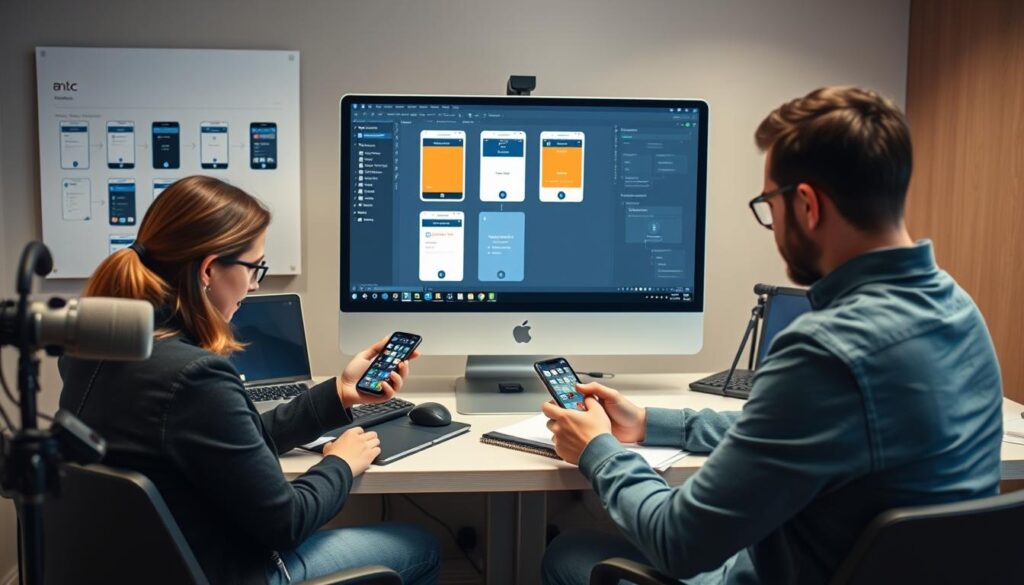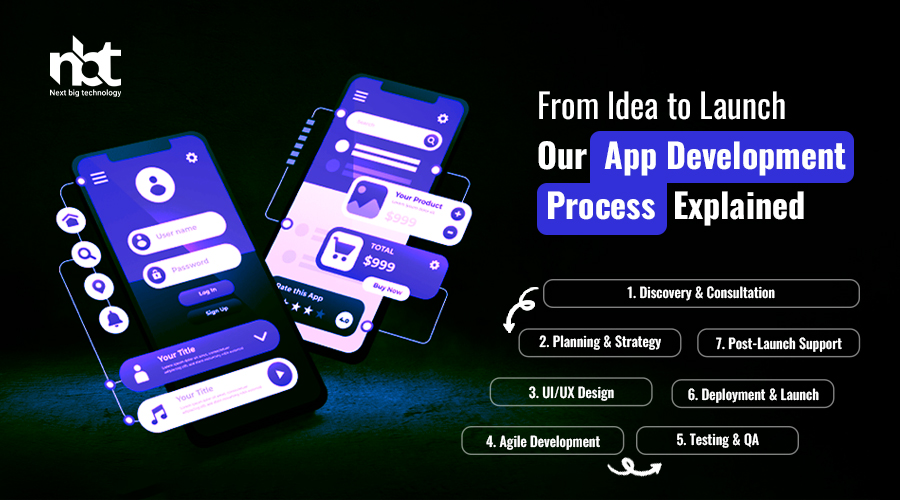Table of Contents
Why a Structured App Development Process Matters
Before diving into our methodology, it’s worth understanding why a well-defined app development process is crucial. In our experience, projects that follow a structured approach are 68% more likely to launch on time and 43% less likely to exceed budget constraints.
A systematic approach to app development provides:
- Clear expectations and milestones for all stakeholders
- Early identification of potential challenges
- Efficient resource allocation throughout the project lifecycle
- Consistent quality standards across all development phases
- Adaptability to changing requirements without derailing progress

Ready to bring your app idea to life?
Schedule a free 30-minute discovery call to discuss your project requirements and learn how our structured development process can help you achieve your goals.
Stage 1: Discovering Your App’s Potential
The discovery phase lays the foundation for your entire app development process. During this critical first stage, we focus on understanding your business objectives, target audience, and the problem your app aims to solve.
Uncovering User Needs Through Research
We begin by conducting comprehensive market research to identify your target audience’s pain points and preferences. This includes analyzing competitor apps, identifying market gaps, and defining unique value propositions that will set your app apart.
Our discovery toolkit includes:
- User interviews and surveys – We use Typeform and SurveyMonkey to gather quantitative and qualitative user insights
- Competitor analysis frameworks – Our proprietary competitive matrix helps identify market opportunities
- Business model canvas – We utilize Strategyzer to map out your app’s value proposition and revenue streams
- User personas development – We create detailed user profiles using UXPressia to guide feature prioritization
Defining Clear Project Requirements
The discovery phase culminates in a comprehensive requirements document that outlines your app’s core functionality, technical specifications, and business objectives. This serves as our roadmap throughout the development process, ensuring all stakeholders share a unified vision.
“The discovery phase saved us from building features our users didn’t actually want. By focusing on real user needs first, we launched with a more focused product that gained traction much faster.”
Risk Management in Discovery
During discovery, we identify potential project risks through our Risk Assessment Matrix. This allows us to proactively address challenges related to technical feasibility, market fit, and resource allocation before development begins. Each identified risk is assigned a mitigation strategy and owner, ensuring nothing falls through the cracks.
Stage 2: Designing Your App’s Experience
With a solid understanding of your requirements, we move into the design phase of the app development process. Here, we transform concepts into visual frameworks that define how users will interact with your application.
Crafting Intuitive Information Architecture
We begin by mapping out your app’s information architecture—the structural foundation that determines how content is organized and how users navigate through the application. This critical step ensures your app feels intuitive and logical from the user’s perspective.
Our design process includes:
- User flow diagrams – Created in Lucidchart to map the complete user journey
- Information architecture maps – Developed using Octopus.do to structure content and navigation
- Wireframing – Low-fidelity layouts created in Figma to establish page structure and content hierarchy

Developing Visual Identity and UI Design
Once the structural elements are approved, our UI designers create the visual language for your app. This includes color schemes, typography, iconography, and other design elements that reflect your brand identity while ensuring optimal usability.
For UI design, we rely on:
- Figma – Our primary design tool for creating high-fidelity mockups and design systems
- Adobe Creative Suite – For specialized graphic elements and illustrations
- Material Design and Apple Human Interface Guidelines – To ensure platform-specific best practices
Risk Management in Design
Design decisions can significantly impact development complexity and user adoption. We mitigate these risks through early stakeholder reviews, competitive design analysis, and accessibility compliance checks. Our design-to-development handoff process includes detailed specifications to prevent implementation discrepancies.
Stage 3: Validating Concepts Through Prototyping
Prototyping bridges the gap between static designs and functional development in the app development process. This crucial phase allows us to test concepts, validate user flows, and gather feedback before committing to full-scale development.

Building Interactive Prototypes
We create interactive prototypes that simulate your app’s functionality, allowing stakeholders and test users to experience the application flow before a single line of code is written. This approach identifies usability issues early when they’re least expensive to fix.
Our prototyping toolkit includes:
- Figma and ProtoPie – For creating interactive, clickable prototypes
- InVision – For collaborative feedback and annotation
- Maze – For remote usability testing and quantitative feedback collection
Conducting User Testing Sessions
We recruit participants matching your target user profiles and conduct structured testing sessions to evaluate the prototype’s usability. These sessions yield invaluable insights that inform design refinements and feature prioritization.
“The prototype testing phase revealed that users were confused by our original navigation structure. By identifying this issue early, we completely redesigned the navigation before development, saving an estimated $30,000 in rework costs.”
Risk Management in Prototyping
Prototyping serves as our first line of defense against usability risks. We use a systematic approach to document and prioritize issues discovered during testing, ensuring critical problems are addressed before development begins. This process typically reduces development rework by 40-60%.
See how prototyping saved time and money
Download our case study to learn how our prototyping process helped a fintech startup reduce development costs by 35% while accelerating their time to market.
Stage 4: Building Your App Through Agile Development
With designs and prototypes approved, we enter the development phase—the stage where your app truly comes to life. Our development approach combines technical excellence with agile methodologies to ensure quality, flexibility, and transparency throughout the app development process.

Establishing Technical Architecture
Before coding begins, our technical architects design a robust foundation for your app. This includes selecting the appropriate technology stack, defining database structures, and establishing API integrations that align with your business requirements and scalability needs.
Our development infrastructure typically includes:
- Frontend frameworks – React Native for cross-platform apps, Swift for iOS, and Kotlin for Android
- Backend technologies – Node.js, Python, or .NET depending on project requirements
- Database solutions – MongoDB for flexible schemas, PostgreSQL for relational data
- DevOps tools – GitHub for version control, Jenkins for CI/CD, Docker for containerization
Implementing Agile Development Cycles
We organize development into two-week sprints, each delivering a potentially shippable increment of your application. This iterative approach allows for regular progress reviews, priority adjustments, and early issue detection.
Our agile development process includes:
- Sprint planning – Using Jira to define and prioritize development tasks
- Daily standups – Brief team meetings to address progress and obstacles
- Sprint reviews – Demonstrations of completed features for stakeholder feedback
- Sprint retrospectives – Team reflections to continuously improve our process
Risk Management in Development
Technical debt and scope creep represent significant risks during development. We mitigate these through code reviews, automated testing, and our Change Request Protocol that evaluates the impact of scope changes on timeline, budget, and quality. Our development teams also maintain a risk register that’s reviewed weekly to address emerging technical challenges.
| Development Phase | Common Risks | Our Mitigation Strategy |
| Technical Architecture | Scalability limitations | Load testing and architecture reviews |
| Frontend Development | Cross-device compatibility issues | Device testing matrix and responsive design principles |
| Backend Development | Security vulnerabilities | OWASP security practices and penetration testing |
| API Integration | Third-party service dependencies | Fallback mechanisms and service monitoring |
Stage 5: Optimizing Performance Through Testing
Quality assurance is integrated throughout our app development process, but dedicated testing phases ensure your application meets the highest standards for functionality, performance, and user experience before launch.

Implementing Comprehensive Testing Protocols
Our testing strategy encompasses multiple dimensions to ensure your app performs flawlessly across devices, operating systems, and user scenarios.
Functional Testing
We verify that every feature works according to specifications using both manual testing and automated test scripts in Selenium and Appium.
Performance Testing
Using JMeter and New Relic, we measure response times, resource usage, and stability under various load conditions to ensure optimal performance.
User Acceptance Testing
We facilitate structured UAT sessions with stakeholders and end-users to validate that the app meets business requirements and user expectations.
Ensuring Cross-Platform Compatibility
For mobile applications, we test across multiple device types, screen sizes, and OS versions using both physical device labs and cloud testing platforms like BrowserStack. This ensures consistent functionality regardless of how users access your application.
Risk Management in Testing
Our risk-based testing approach prioritizes critical functionality and high-traffic user paths to maximize test coverage efficiency. We maintain a comprehensive test case repository that evolves with your application, ensuring regression testing captures potential issues introduced by new features or updates.
“The rigorous testing process uncovered several edge cases we hadn’t considered. Addressing these before launch prevented what could have been a significant user experience issue affecting approximately 15% of our user base.”
Stage 6: Executing a Successful App Launch
Launching your app is more than just publishing it to app stores—it’s a coordinated effort that requires careful planning and execution. Our launch phase ensures your application enters the market with maximum impact and minimal friction.
Preparing for App Store Submission
We handle all aspects of app store preparation, including:
- App store optimization (ASO) – Crafting compelling listings with researched keywords, screenshots, and preview videos
- Technical requirements – Ensuring compliance with Apple App Store and Google Play Store guidelines
- Content rating and legal compliance – Managing privacy policies, terms of service, and content ratings
Implementing Launch Marketing Support
A great app needs visibility to succeed. We work with your marketing team to coordinate:
- Pre-launch campaigns – Building anticipation through email marketing, social media, and PR
- Launch day activities – Coordinating announcements across channels
- User acquisition strategies – Implementing tracking for marketing campaigns

Risk Management in Launch
Launch delays and technical issues can impact market momentum. We mitigate these risks through our Launch Readiness Checklist and phased rollout strategy. Our 24/7 launch support team monitors performance metrics and user feedback during the critical first days, ready to address any issues that emerge.
| Launch Component | Tools Used | Risk Mitigation |
| App Store Submission | App Store Connect, Google Play Console | Pre-submission compliance review |
| User Analytics | Firebase, Mixpanel | Real-time monitoring dashboard |
| Crash Reporting | Crashlytics, Sentry | Automated alerts and hotfix protocol |
| User Feedback | AppFollow, UserVoice | 24/7 review monitoring team |
Stage 7: Growing Your App Through Post-Launch Support
The app development process doesn’t end at launch. In many ways, it’s just beginning. Our post-launch phase focuses on monitoring performance, gathering user feedback, and implementing improvements that drive long-term success.

Analyzing User Behavior and Performance
We implement comprehensive analytics to understand how users interact with your application, identifying opportunities for optimization and feature enhancement.
Our analytics infrastructure includes:
- User behavior tracking – Using Google Analytics and Mixpanel to map user journeys
- Performance monitoring – Implementing New Relic and Firebase Performance Monitoring
- Crash reporting – Deploying Crashlytics to identify and resolve issues
Implementing Continuous Improvement Cycles
Based on analytics insights and user feedback, we develop a roadmap for ongoing enhancements. These are delivered through regular update cycles that keep your app fresh, competitive, and aligned with evolving user needs.
Risk Management in Post-Launch
User retention and engagement represent key post-launch risks. We address these through our Early Warning System that identifies concerning metrics trends, and our Feature Impact Analysis that evaluates how changes affect core user behaviors. This data-driven approach ensures your app continues to meet business objectives over time.
Ready to start your app development journey?
Let’s discuss how our proven process can bring your app idea to life. Schedule a consultation with our expert team to explore possibilities and next steps.
Case Study: App Development Process Timeline Comparison
To illustrate how our app development process adapts to different project requirements, let’s compare two recent applications we developed: a feature-rich e-commerce platform and a focused healthcare scheduling app.

E-Commerce Platform (26 Weeks)
- Discovery: 3 weeks – Extended market research and complex user journey mapping
- Design: 4 weeks – Extensive product catalog UI and checkout flow optimization
- Prototyping: 2 weeks – Multiple iterations based on user testing feedback
- Development: 10 weeks – Payment gateway integration and inventory management system
- Testing: 4 weeks – Comprehensive security and performance testing
- Launch: 1 week – Coordinated with marketing campaign
- Post-Launch: 2 weeks – Intensive monitoring and optimization
Healthcare Scheduling App (14 Weeks)
- Discovery: 2 weeks – Focused requirements gathering with key stakeholders
- Design: 2 weeks – Streamlined UI with accessibility focus
- Prototyping: 1 week – Rapid validation with practitioner feedback
- Development: 5 weeks – Core scheduling functionality and calendar integration
- Testing: 2 weeks – HIPAA compliance and cross-device testing
- Launch: 1 week – Phased rollout to clinical staff
- Post-Launch: 1 week – User training and feedback collection
Key Timeline Factors
Several factors influenced the timeline differences between these projects:
Feature Complexity
The e-commerce app required integration with multiple third-party services and complex business logic, extending development time significantly.
User Base Size
The healthcare app targeted a specific professional user group, allowing for more focused testing and streamlined requirements.
Regulatory Requirements
Healthcare compliance added complexity to certain phases but was offset by the narrower feature scope compared to the e-commerce platform.
“Understanding that each app has unique requirements helped us set realistic expectations. The timeline comparison showed us exactly where our project needed extra attention and where we could streamline.”
Key Lessons From 5+ Years of App Development
After guiding dozens of applications from concept to successful launch, we’ve identified several critical insights that consistently contribute to project success:

Invest in Discovery
Projects that allocate sufficient time for research and requirement definition consistently experience fewer scope changes and better alignment with user needs. We’ve found that adding just one extra week to discovery can reduce development rework by up to 30%.
Prototype Before Building
Interactive prototypes have proven invaluable for validating concepts before committing development resources. Even simple prototypes can reveal critical usability issues that would be expensive to fix later in the app development process.
Embrace Iterative Development
Breaking development into smaller increments allows for regular feedback and course correction. This approach has consistently delivered better outcomes than attempting to build the entire application before review.
Prioritize User Feedback
The most successful apps are those that incorporate user input throughout development. Establishing feedback channels early and responding to insights quickly leads to higher user satisfaction and retention rates.
Plan for Post-Launch
Apps that allocate resources for post-launch optimization see significantly better performance metrics. The first 30 days after launch provide critical data that should inform immediate improvements.
Balance Innovation and Familiarity
The most successful apps strike a balance between innovative features and familiar interaction patterns. Completely novel interfaces often face adoption challenges despite technical excellence.
Ready to Start Your App Development Journey?
The app development process we’ve outlined represents our commitment to creating applications that not only meet technical standards but deliver real business value. By combining structured methodology with creative problem-solving, we help organizations transform ideas into impactful digital products.
Every successful app begins with a conversation about possibilities. Whether you have a detailed specification or just the seed of an idea, our team is ready to guide you through each stage of the journey from concept to launch and beyond.











